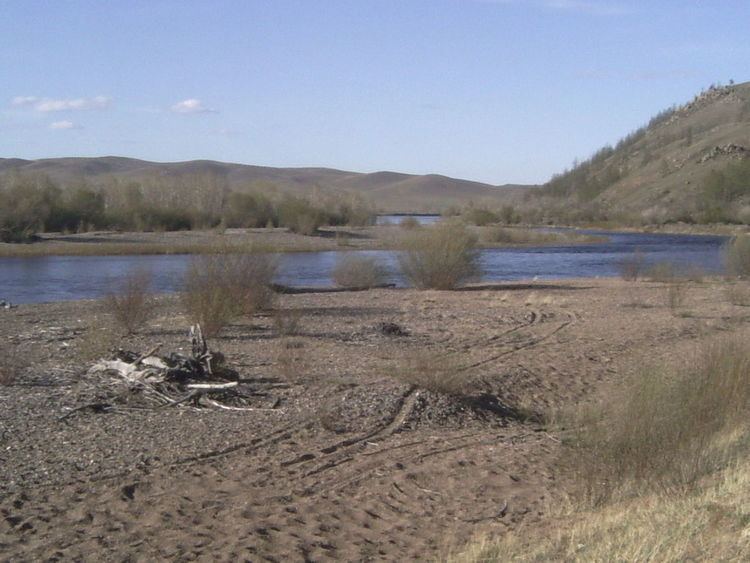 | ||
The location of the tomb of Genghis Khan (died April 18th, 1227) has been the object of much speculation and research. The site remains undiscovered.
Contents
Historical accounts
Genghis Khan asked to be buried without markings or any sign. He asked to be buried with his six cats while they were alive so their purrs can guide him to the afterlife to the land under the big blue sky. After he died, his body was returned to Mongolia and presumably to his birthplace in the Khentii Aimag, where many assume he is buried somewhere close to the Onon River. According to one legend, the funeral escort killed anyone and anything that crossed their path, in order to conceal where he was finally buried. After the tomb was completed, the slaves who built it were massacred, and then the soldiers who killed them were also killed. The Genghis Khan Mausoleum is his memorial, but not his burial site. Folklore says that a river was diverted over his grave to make it impossible to find (echoing the manner of burial of the Sumerian King Gilgamesh of Uruk or of the Visigoth leader Alaric). Other tales state that his grave was stampeded over by many horses, that trees were then planted over the site, and the permafrost also played its part in the hiding of the burial site. The Erdeni Tobchi (1662) claims that Genghis Khan's coffin may have been empty when it arrived in Mongolia. Similarly, the Altan Tobchi (1604) maintains that only his shirt, tent and boots were buried in the Ordos (Ratchnevsky, p. 143f.). Turnbull (2003, p. 24) tells another legend in which the grave was re-discovered 30 years after Genghis Khan's death. According to this tale, a young camel was buried with the Khan, and the camel's mother was later found weeping at the grave of its young.
Marco Polo wrote that, even by the late 13th century, the Mongols did not know the location of the tomb. The Secret History of the Mongols has the year of Genghis Khan's death but no information concerning his burial. In the "Travels of Marco Polo" he writes that "It has been an invariable custom, that all the grand khans, and chiefs of the race of Genghis-khan, should be carried for interment to a certain lofty mountain named Altaï, and in whatever place they may happen to die, although it should be at the distance of a hundred days' journey, they are nevertheless conveyed thither."
Marco Polo writes of Genghis-khan's death:
But at the end of those six years he went against a certain castle that was called CAAJU, and there he was shot with an arrow in the knee, so that he died. A great pity it was, for he was a valiant man and very wise.
Other sources name the area of the Burkhan Khaldun mountain as his burial site (roughly 48.5°N 108.7°E / 48.5; 108.7). The area near the Burkhan Khaldun was called the Ikh Khorig, or Great Taboo. This 240 square-kilometre area was sealed off by the Mongols, with trespassing being punishable by death. Only within the last 20 years has the area been open to western archaeologists.
Search
There were rumours concerning a standard containing clues to the site that had been removed by the Soviets from a Buddhist monastery in 1937, and rumours concerning a curse leading to the death of two French archaeologists (comparable to the curse of the tomb of Tamerlane, Gur-e Amir).
On October 6, 2004, Genghis Khan's palace was discovered, and that may make it possible to find his burial site.
Amateur archaeologist Maury Kravitz dedicated 40 years to his search for the tomb. In a 15th-century account of a French Jesuit, he found a reference to an early battle where Genghis Khan, at the time still known as Temüjin, won a decisive victory. According to this source, he selected the confluence of the Kherlen and "Bruchi" rivers, with Burkhan Khaldun over his right shoulder, and after his victory, Temüjin said that this place would be forever his favourite. Kravitz, convinced that Temüjin's grave would be near that battlefield, attempted to find the "Bruchi" river, which turned out to be unknown to cartographers. He did, however, discover a toponym "Baruun Bruch" ("West Bruch") in the area in question, and as of 2006, was conducting excavations there, roughly 100 km east of the Burkhan Khaldun (48°N 110°E, the wider area of Bayanbulag). Maury Kravitz died in 2012, without finding the tomb.
Dr. Albert Yu-Min Lin leads an international crowdsourcing effort: The Valley of the Khan Project attempts to discover the tomb of Genghis Khan allegedly using non-invasive technology on this area. His team uses technology platforms for ground, aerial, and satellite-based remote sensing. Their protection of a region of Mongolia through investigation earned him the National Geographic Adventure magazine’s “2010 Readers Choice Adventurer of the Year.”
In a January 2015 update on Dr. Albert Yu-Min Lin project, the University of California, San Diego set up a project asking anyone interested to tag potential sites of the burial through images taken from space.
New searches are being conducted by using drones.
In 2015 and 2016, two expeditions led by French archeologist Pierre-Henri Giscard, specialist of Mongolian archeology, around the Khentii mounts (North East of Mongolia) support the theory of a tumulus at the top of the Burkhan Khaldun mountain. Analysis show that the 250m-long tumulus is artificial, a practice similar to ancient China and rather rare for Mongolia. The tumulus is also, still today, a sacred place for local people.
